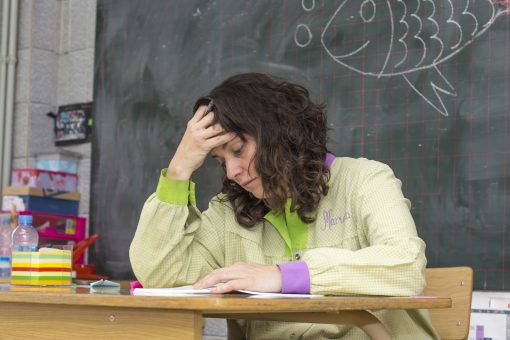
By Ann Schulte & Devon Brenner
The last two years have been challenging everywhere, but teachers who work in rural communities may have experienced challenges unique to their place. Rural schools have served as temporary shelters for evacuees and first responders, have been closed as communities wait for disaster relief, or students have lost their schools altogether. Countless numbers of rural communities across the country have been impacted by hurricanes, mudslides, wildfires, and tornadoes. On top of these natural disasters, challenges related to Covid-19 were exacerbated because of sparse broadband availability and limited access to healthcare.
Because rural economies are often based on industries such as mining, forestry, and tourism, the continuing economic impacts of the pandemic are creating additional stress, anxiety, and depression. These collective traumas of natural disasters, the pandemic, and economic uncertainty have hit rural places particularly hard over the past few years, and no doubt rural teachers have felt the brunt of it.
Teachers may be dealing with illness and disaster within their own families while they must also help students, in person and online, navigate similar challenges. Teachers in rural schools and districts, where access to health care, counseling, and social services may be limited, are often called upon to help their students and families beyond academics-by helping coordinate meals, helping families find shelter, or helping their students respond during and after the crisis. This kind of work can cause teachers to experience both primary and secondary trauma.
What is Trauma?
Trauma is a term “to describe the aftermath or impact of an event, whether real or perceived, that interrupts a person’s ability to maintain a sense of psychological and/or physical safety and well-being” (Berardi & Morton, 2019, p. xiii). In other words, trauma causes emotional, physical, and social responses that make it difficult to continue with normal day-to-day activities. This is because trauma impacts the brain. In response to trauma, the survival parts of the brain will cause the body to fight, flee, or freeze. If a person is experiencing persistent trauma, the repeated survival reactions in the brainstem and limbic region can interfere with the thinking part of the brain. The accumulation of disruption to the typical functioning of the parts of the brain can result in unhealthy and harmful outcomes (Perry & Szalavitz, 2006).
Trauma can occur individually or collectively. Individuals may experience instances of tragedy, violence, or persistent discrimination that can result in personal trauma. Some forms of trauma are more likely to be present in rural communities. Flash floods, tornadoes, and wildfires as well as droughts, immigration raids, and factory closings are all forms of collective trauma experienced to varying degrees by everyone in a community. Trauma can happen as a single collective event, but generational poverty in regions of historical neglect can also lead to several types of adverse community outcomes including shorter life expectancy, higher infant mortality rates, and higher death rates (Czapp & Kovach, 2021). Rural teachers work at the intersection of these types of trauma.
Secondary Trauma
Primary trauma happens to an individual. Secondary trauma is the emotional stress that can happen when an individual in a caregiving role experiences the traumatic experiences of others vicariously (van Dernoot Lipsky, 2009). When you are called on to help others survive and get beyond a trauma, you may internally experience some of that trauma yourself. Teachers may experience secondary trauma as they are caring for and helping their students. Secondary trauma can cause teachers to feel helpless or hopeless, or experience feelings of guilt, fear, and anxiety. Secondary trauma can cause an inability to embrace complexity, seeing things as only right or wrong, unable to embrace the gray area. When teachers are called on to make many critical decisions in a short time to help their students survive, understanding nuances can seem more difficult. Feelings of being overwhelmed or unable to help may lead to compassion fatigue, which can have negative consequences for students. Teachers experiencing secondary trauma may also experience higher rates of substance abuse and burnout (van Dernoot Lipsky, 2009)
Trauma and Rural Places
Although not all of these challenges may impact every rural teacher, there are some unique characteristics of rural places that might heighten the need for teachers and administrators to understand the effects of both primary and secondary trauma. A common strength of a small town is a strong sense of community, but that also means that privacy can be harder to come by. It may be more difficult for a teacher to take a break from her students’ traumas if she is seeing them around town, or if they are members of their own extended family! This lack of anonymity can also make it harder for a rural teacher to privately find a therapist in her community. In some areas of the country, there is little or no access to mental health professionals even if the person can afford the expense. Despite the increase in telehealth services since the pandemic, this type of access is only as good as strong broadband. Finally, some teachers may have been raised in cultures that associate shame or embarrassment about asking for help. Without sufficient support during times of trauma, teachers may be more likely to leave the profession, exacerbating the problems related to recruitment and retention already endemic in most rural communities.
Individuals experience their trauma in a very personal way, but how the teaching profession responds can help to create a supportive system that enables individuals to more easily care for themselves and, in turn, their students. Creating systems that are ready to help people, no matter what happens, can lead to healthier individuals as well as a better functioning community of educators.
Trauma Response Should be a System Response
Empathetic educators will experience secondary trauma in typical circumstances, but when a crisis or trauma event impacts the whole community, there is an even greater need for a system of supportive practices of care. In most communities, some types of trauma are inevitable, and teachers should not feel that they are on their own navigating these issues. People doing the helping, people like teachers, need extra support during times of trauma-helpers may seem to be doing just fine as they are working with their emotional reserves. But teachers experiencing both primary and secondary trauma will need support, whether they ask for it or not. To create environments that respond to trauma, administrators can implement practices that foster a district culture of wellness that acknowledges and responds to secondary trauma and its consequences.
One way to start is to read a book in common. We think Trauma Stewardship (van Dernoot Lipsky, 2009) is a good place to begin learning about how to recognize and respond to secondary trauma. The book explains what trauma is, gives 16 signs and symptoms of trauma exposure, and offers several strategies for establishing sustainable healthy practices that tend to one’s trauma exposure. Staying present in one’s own struggles enables us to more fully care for others in their time of need. This is why reading a book together and developing shared practices benefits both the individual and the community of colleagues.
Another strategy is to build in time during the school day for teachers to support one another. For example, professional development days should include opportunities for teachers to connect with one another. The impulse may be to spend PD time focusing on learning new technology for remote teaching or ways to accelerate learning, but investing time in just talking, sharing, and supporting one another can be even more important. Taking time to listen to one another is an important investment in teachers’ well-being. Teachers can also improve their own self-care habits by sharing ideas with each other about how to model strategies in the district-adopted social-emotional learning (SEL) programs for students. For example, positive affirmations can be just as powerful for adults as they are for children. Too often, teachers are thinking only of their students’ needs and are missing opportunities to focus on their own care as well.
Just as teachers often focus on their students’ trauma recovery, at the expense of their own, school administrators might overlook the cumulative effect of caring for a district full of others’ trauma. After a gunman went on a shooting spree in a small northern California town, where the elementary school was one of the targets, the principal and superintendent harnessed all of the counseling and support services they could for the teachers and children in their care. But a year after the shooting, the principal admitted that while they were so focused on the teachers and students, they had neglected to create an explicit system of support for the district leaders and they were suffering as a result. Community trauma impacts everyone and school leaders cannot forget to include themselves in this important work.
Finally, it’s important to leverage all of the resources that are provided to your district. Districts that have healthcare plans that cover mental health screenings can actively promote these services on a regular basis. Administrators can remind teachers that sick days are available for both physical and mental health. A district culture that is explicitly responsive to both individual and collective trauma reduces the stigma associated with mental health and can also reduce cultural or linguistic barriers to asking for help.
Self-care for Individuals
There is an increasing conversation about “trauma-informed practices” that teachers can use to recognize and support students in trauma (Pawlo, et al., 2019), but more needs to be done to support teachers during traumatic times. Teachers whose district has not yet developed an institutional commitment to trauma-responsive care for educators can develop several self-care habits for themselves. The amount of personal, familial, and community resources a person has in their life can help to determine how that person is able to recover from a traumatic event. It is helpful if teachers know about and get in the habit of practices that support wellbeing. These might include:
ExerciseMetabolizing stress means to engage with and process the stress rather than make yourself numb to it. Endorphins improve mood and neurohormones improve cognition, helping the body to recover from the physical symptoms of stress. Integrating exercise into parts of your school day is not only positive for your well-being, but also provides an authentic model of the importance of self-care for your students. Meditation and MindfulnessFor many people, it can be helpful to take a few moments each day to meditate or focus on something positive. In the pressure to respond to a crisis, sometimes we forget to just stop and breathe. There seems to be no shortage of digital resources to help make that a habit. For example, Calm, Simple Habit, and Ten Percent Happier are all apps that offer mindfulness meditation practices and are easily accessible for most people. JournalingWriting is one way of reflecting, reconnecting with your purpose, or processing your emotions. In their book about rural teaching, Azano, et al (2021) describe these questions as helpful journaling prompts:
The OutdoorsRural schools may have unique strengths for enabling self-care habits. If your school context provides for convenient access to natural spaces, invite your students to join you (or get away by yourself!) on lunch-time nature walks. School staff can be trained in nature therapy that can help in reducing stress and anxiety (See Association of Nature and Forest Therapy). Just the simple process of standing outside and using all of one’s senses to deeply experience the surroundings helps to calm the parasympathetic nervous system. The CommuteFor those who have a longer commute to their school, intentionally use that time to unwind and breathe. Keep safe driving your main focus, but use the time to reflect on what went well in your day, listen to rejuvenating music or inspiring podcasts, or just be quiet as you focus on your breathing. Mental Health ResourcesA trained, supportive therapist can be invaluable for educators experiencing secondary trauma. In areas where mental health professionals are not available, telehealth may be an option. Many people experienced Zoom fatigue during the past year, but if more rural people can take advantage of the increased telehealth opportunities afforded during the pandemic, remote therapy may continue to be made available for rural places (Uscher-Pines & Martineau, 2021). |
Put On Your Own Mask First
Anyone who has ever been on a plane knows that the flight attendant instructs the passengers, “In case of emergency… please place the oxygen mask over your own mouth and nose before assisting others.” Educators have to take care of themselves in order to have something left to give to others. School administrators can do a lot to create conditions that support self-care and to develop a district culture that embraces a humanizing approach to professional development and collaboration. The past couple years have been traumatic in so many ways for teachers. Let’s take time to reimagine how we structure systemic support for everyone in our schools.

Anne Schulte is a professor of education at California State University. |

Devon Brenner is a professor of teacher education at Mississippi State University. |
References
Association of Nature and Forest Therapy. https://www.natureandforesttherapy.earth/
Azano, A. P., Brenner, D., Downey, J., Eppley, K., & Schulte, A. K. (2021). Teaching in Rural Places: Thriving in Classrooms, Schools, and Communities. Routledge.
Berardi, A., & Morton, B. (2019). Trauma-informed school practices: Building expertise to transform schools. George Fox University. https://digitalcommons.georgefox.edu/pennington_epress/4
Czapp, P., & Kovach, K. Poverty and health – the family medicine perspective (position paper). American Academy of Family Physicians. http://www.aafp.org/about/policies/all/policy-povertyhealth.html
Pawlo, E., Lorenzo, A., Eichert, B., and Ellis, M.J. (2019, Oct. 28). All SEL should be trauma-informed. Phi Delta Kappan, 101 (3), 37-41.
Perry, B. D., & Szalavitz, M. D. (2006). The boy who was raised as a dog. Basic Books.
Uscher-Pines, L & Martineau, M. (January, 2021). Telehealth After COVID-19
Clarifying Policy Goals for a Way Forward. Rand Corporation.
https://www.rand.org/content/dam/rand/pubs/perspectives/PEA1000/PEA1089-1/RAND_PEA1089-1.pdf
van Dernoot Lipsky, L. (2009). Trauma stewardship: An everyday guide to caring for self while caring for others. Berrett-Koehler.
